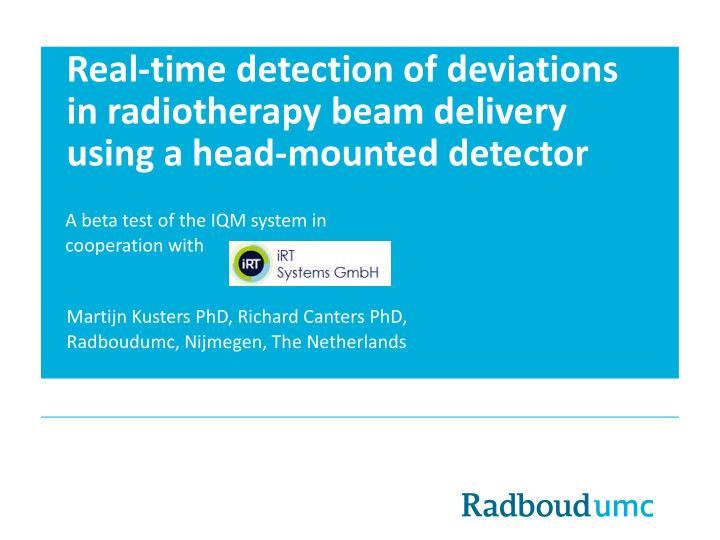



Real-time detection of deviations in radiotherapy beam delivery using a head-mounted detector A beta test of the IQM system in cooperation with Martijn Kusters PhD, Richard Canters PhD, Radboudumc, Nijmegen, The Netherlands
Outline • Current practice of treatment monitoring • The IQM system • Testing the IQM system • Discussion & Conclusions
Current practice Prescription Patient Dose
Current practice Errors in Delta 4 pre treatment QA Prescription TPS R&V Linac -- Not always treatment linac Transfer -- Not always treatment linac Absolute dosimetry -- Not always treatment linac Delivered beam Dose in patient
Solutions to monitor the delivered beam (and patient) • Relatively easy • Checks your linacs • Actual patient is Monitor fluence not monitored from linac head Epid dosimetry • Harder to implement and more labour intensive • Actual delivered dose to the patient can be made visible
Error detection with in vivo monitoring Errors in Delta 4 pre treatment Epid dosimetry Linac head QA monitor Prescription TPS R&V Linac -- Not always treatment linac Transfer -- Not always treatment linac Absolute dosimetry -- Not always treatment linac Delivered patient beam Dose in patient
Error detection with in vivo monitoring Errors in Delta 4 pre treatment QA Prescription TPS R&V Linac -- Not always treatment linac Transfer -- Not always treatment linac Absolute dosimetry -- Not always treatment linac Delivered beam Dose in patient
The IQM system Integral Quality Monitor Wedge shaped ionization chamber Signal dependent on: • Field/segment position • Field size and shape • Monitor units Checksum one number, sensitive for many parameters C MU AOF ( x , y ) I S ( x , y ) IQM field Area
Intended use of the IQM system • In vivo treatment monitoring • Realtime monitoring of beam delivery • Increased patient safety • Insight in the linac behaviour per segment/control point • Pre-treatment QA • Can be run in between regular treatments or whenever there is free time. • RTT’s can run the tests • Reduces a substantial effort in pre- treatment QA • Possible to measure plans during 1st fraction if not critical.
Tests:error detection sensitivity How well does IQM perform in intra-fractional detection? • Various IMRT and VMAT clinical beams, • Same beams with induced errors • One segment/control point retraction of leaves by 10, 5 and 2 mm • One segment increase of 10, 5 or 2 MU • Comparison to Delta4 Cumulative checksum Per segment checksum 300000 25000 250000 20000 Checksum Checksum 200000 15000 150000 10000 100000 5000 50000 0 0 0 5 10 15 20 25 30 0 5 10 15 20 25 30 Segment Segment
Testing the IQM system – detecting errors: one segment different MU • • 10MU 5MU • 2MU IQM IQM IQM Maximum difference in cumulative signal [%] Maximum difference in cumulative signal [%] Maximum difference in cumulative signal [%] 1 1 10 10 VMAT clinical VMAT clinical VMAT clinical VMAT clinical IMRT clinical VMAT modified IMRT clinical IMRT clinical VMAT modified VMAT modified VMAT modified 1 10 IMRT modified IMRT modified IMRT modified 0 0 10 10 0 10 -1 -1 10 10 -1 10 0 1 2 0 1 2 0 1 2 10 10 10 10 10 10 10 10 10 Maximum difference in segment signal [%] Maximum difference in segment signal [%] Maximum difference in segment signal [%]
Testing the IQM system – detecting errors: one segment leaf retraction • • • 10mm 5mm 2mm IQM IQM IQM Maximum difference in cumulative signal [%] Maximum difference in cumulative signal [%] Maximum difference in cumulative signal [%] 2 2 2 10 10 10 VMAT clinical VMAT clinical VMAT clinical IMRT clinical IMRT clinical IMRT clinical VMAT modified VMAT modified VMAT modified IMRT modified IMRT modified IMRT modified 1 1 1 10 10 10 0 0 0 10 10 10 -1 -1 -1 10 10 10 0 1 2 0 1 2 0 1 2 10 10 10 10 10 10 10 10 10 Maximum difference in segment signal [%] Maximum difference in segment signal [%] Maximum difference in segment signal [%]
The ROC-curve VMAT modified Maximum difference in cumulative Sensitivity/specificity Sensitivity/specificity Sensitivity/specificity IMRT modified 100 100 100 90 90 90 0 10 80 80 80 Sensitivity [%] Sensitivity [%] Sensitivity [%] 70 70 70 60 60 60 50 50 50 40 40 40 30 30 30 -1 20 20 20 10 10 10 10 0 0 0 0 1 2 10090 80 70 60 50 40 30 20 10 0 10090 80 70 60 50 40 30 20 10 0 10090 80 70 60 50 40 30 20 10 0 10 10 10 Specificity [%] Specificity [%] Specificity [%] Maximum difference in segment signal [%]
Testing the IQM system – detecting errors • 10mm leaf retraction, 10MU • 5mm, 5MU • 2 mm, 2 MU Sensitivity/specificity Sensitivity/specificity Sensitivity/specificity 100 100 100 IQM IQM IQM 90 90 90 Delta4 Delta4 Delta4 80 80 80 70 70 70 Sensitivity [%] Sensitivity [%] Sensitivity [%] 60 60 60 50 50 50 40 40 40 30 30 30 20 20 20 10 10 10 0 0 0 100 90 80 70 60 50 40 30 20 10 0 100 90 80 70 60 50 40 30 20 10 0 100 90 80 70 60 50 40 30 20 10 0 Specificity [%] Specificity [%] Specificity [%]
Discussion & Conclusions • IQM enables realtime, intrafraction monitoring of beam delivery • Sensitivity and specificity can be expected to be sufficient for clinical practice, and at least equal to our current equipment • Pre-treatment QA with IQM has the potential to save a lot of time, but has yet to be tested
Conclusions Calculate Compare with Prescription plan measured Checksum checksum Error detection Realtime monitoring with well below almost no user interaction clinically relevant limits Patient Dose
Recommend
More recommend